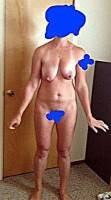Hernia repair tummy tuck
The operation to repair a diastasis recti as well as to remove excess skin is a tummy tuck.
Repair of the diastasis in you would require release of the belly button so that the surgeon can access the entire abdominal wall fascia from the bottom of the ribcage to the pubic bone for repair.
At the same time, this provides excellent access for repair of your umbilical and ventral hernias. I work with a general surgeon who repairs the hernias after I provide the exposure, and then I continue with the rest of the tummy tuck.
There are some variations of tummy tuck to consider. A lower or “mini” tummy tuck will not provide full access for what I have described above, and does not appear to be a good option for you.
If there is skin excess above the belly button, then a full tummy tuck would be needed to pull this skin tight, involving the lower abdominal horizontal scar beneath a swimsuit line, as well as a scar around the belly button and most likely a small vertical scar lower on the tummy where the old belly button hole moves down and needs to be closed. (Only if you have a fair amount of upper abdominal loose skin will this hole be moved down enough to be completely removed.)
Another option in someone who needs muscle/fascia repair to the full abdomen BUT does not have much skin excess above the belly button is to release the belly button at the base of its stalk beneath the surface of the skin, repair the hernias and diastasis, and then set the belly button back down where you found it.
If the belly button is a bit high on someone with a long torso, bringing it down a centimeter or two before reinserting it may be possible, and this would pull the skin above the belly button a little tighter if this was needed.
This is called an “umbilical float”. Obviously, this is not an option in patients whose belly button would look weird if lowered. You may in fact be a candidate for this, thus avoiding the belly button scar and the small vertical scar, but this would need to be determined on examination. (Robert M. Grenley, MD, Seattle Plastic Surgeon)
Tummy tuck for what exercise can’t do
You have figured out that exercise doesn’t correct the diastasis, and it won’t tighten loose skin. A tummy tuck is usually the best option in those cases, and any board-certified plastic surgeon should be able to give you a nice result. Usually best to see more than one before deciding. (Richard Baxter, MD, Seattle Plastic Surgeon)
Respectfully disagree
I’m not sure you do need a tummy tuck. You can have the diastasis repaired without skin excision and from your photos, I’m not sure you have much skin to excise. The type of repair of your rectus would really depend on the degree of laxity. If it were severe we might need to interpose a piece of allograft or xenograft and consider a component separation to mobilize healthy strong tissue to the midline. (Robert Frank, MD, Munster Plastic Surgeon)
Tummy Tucks for Thin, Athletic Women
It’s always hard to know exactly what your options would be without an examination, but based on what you’re saying I think a tummy tuck would be an excellent option, the goals of which would be to repair the rectus diastasis, repair the hernias and remove excess skin. In terms of picking a surgeon, most of us operate on a wide variety of patient body types, so I would recommend checking out the photo galleries of a few surgeons in your area to get a sense of the results they can achieve and then maybe set up a couple of consults to find the surgeon that you feel the most comfortable with. (Shahram Salemy, MD, FACS, Seattle Plastic Surgeon)
Based on your pictures and your description I think you will be an excellent candidate for a full tummy tuck procedure. This procedure will allow removal of the excess skin and subcutaneous tissues, repair of the diastasis recti, and repair of the abdominal wall hernias. In regards to selecting a surgeon, unfortunately there is no good way to do this besides doing your own due diligence. I would start off by making sure your surgeon is a well experienced board-certified plastic surgeon and then ask to see many examples of similar body type patients that he/she has taken care of. You may even be able to speak to some previous patients. (Tom J. Pousti, MD, FACS, San Diego Plastic Surgeon)
Rectus diastasis and tummy tucks
It is always a challenge to give advice without an exam. From the photos, it does look like you would be a good candidate for eithe a modified or a full adominoplasty depending on your skin laxity. Patients with a severe rectus diastasis frequently also have umbilical (belly button) hernias.
One of the more important aspects of a tummy tuck is the plication or tightening of the rectus fascia (connective tissue covering the abdominal muscles) with permanent sutures. This repairs the rectus diastasis.
Most plastic surgeons will repair the umbilical hernia at the same time, or have a general surgeon do while it is exposed. Apart from realself.com, another good way for patients to find a board certified plastic surgeon in their area is at the ASPS website (plasticsurgery.org). It is never a bad idea to speak to a couple plastic surgeons before making up one’s mind.
Patients should ask their plastic surgeon about their experience, and get an opportunity to review photos of patients similar to them. (Kelly Gallego, MD, FACS, Yuba City Plastic Surgeon)
Mini Tummy Tuck on an athletic patient
In general , a thin fit patient with excessive lower abdominal skin and rectus diastasis would benefit from a mini tummy tuck through which the rectus diastasis and umbilical hernia are treated simultaneously. Quite a few patients have similar concerns. (Ali Adibfar, MD, DDS, Toronto Plastic Surgeon)











